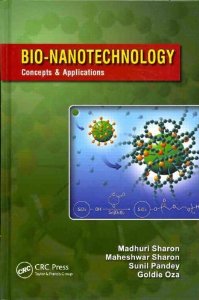Bio-Nanotechnology: Concept & Applications 1st Edition Hardcover
by Madhuri Sharon, Maheshwar Sharon, Sunil Pandey, Goldie Oza

Bio-Nanotechnology: Concepts and Applications
ISBN 1439852146 – 300 pages $66.31 on Amazon Published May 2012
I am more than a bit surprised that a fresh book in such a cutting edge field is so inexpensive and seems to be a bit unknown at this time. (at least I am not seeing any reviews on Amazon as of this writing)
Despite some flaws and shortcomings, this is quickly becoming one of my favorite texts on the subject.
There is definitely more of a bias towards helpful illustrations, photos and diagrams in here than there are equations, so this is NOT a hard-core reference manual, but it is an excellent overview of some of the latest concepts and approaches in the field of bio-nanotechnology.
The areas covered are broad and what I find to be the most valuable contribution of this work is the ILLUMINATION that it provides on fundamental concepts that are too often obscured by analysis and math symbology. For example, the chapter on ATP Synthase motor dynamics is the most detailed and yet most understandable explanation I have yet encountered on this almost supernaturally efficient wonder of nature.
There are numerous other eureka moments I encountered throughout the book while reading; the kind of “Aha!” transitions that professors and PhD students allude to when you reach a certain quantum leap in understanding and you glimpse how all sorts of “First Principles” converge, interconnect and hang together.
The only detraction at times is the glaring grammatical mistakes in certain chapters that are the obvious result of mistranslated material and/or a lack of good proofreading. This may seem picky, but in some cases the error is of such a magnitude that the technical meaning is distorted into misinformation. In one case, the number of hydrogen bonds between nitrogenous bases is incorrectly illustrated as 2 for both A & T and C & G with the ring order in DNA accidentally reversed. (the correct number is 2 and 3 respectively) Still, a sharp student or professor should be able to suss out the wheat from the chaff; I just look forward to a 2nd edition that has been more carefully edited.
All in all, if you want a good technical overview of trends in bionanotechnology or just need to review the basics, then this is a must have, but I don’t find it suitable as a primary academic textbook. (but a recommended supplement)



